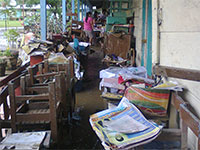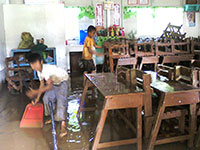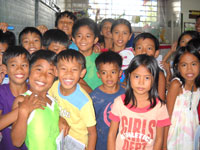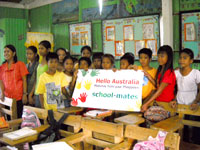Our Schools
There are many public schools in the rural Philippines that urgently need assistance to educate the disadvantaged students of these communities.
Many schools have limited electricity, no fresh water, unsatisfactory toilet facilities, rundown classrooms, no sporting equipment or facilities and no canteens.
There are definitely no computers, no calculators, no science labs or no libraries. There are no school-buses, many children walk many kilometers to school, others arrive in overfilled tricycles or three or four to a moped from the further rural areas. It is the sheer devotion of the teachers and villagers that keep the schools operating by doing painting and maintenance at their own expense.
Everything that we send these schools helps, kids need a simple pencil and pad to attend school, we can provide these small items to the very needy, all of our recycled school supplies help the whole school, any sports gear creates a whole new experience, recycled toys bring huge smiles, and recycled clothing show the students that someone else really cares.
Your help shows these disadvantaged kids that someone from a faraway place, cares about them, cares about their education, and cares about their faith in humanity, thank you.
The maliyaa foundation presently have 54 schools in immediate need of Australian schoolmates, the following schools are just an example of some of the schools available for adoption by Australian schools, please sign up today to help our needy neighbours.
Natural Disasters = Devastation
Paringao Elementary School after Typhoon in November 2012.
This is the sister School of Lycee Condorcet French School of Sydney
What do They Need?
A notebook and pencil are the minimum requirements for a child to attend Public Elementary School in the Philippines. Unfortunately, many families can't afford these simple items that we in Australia merely take for granted. Hence the child does not commence school. They also need many other basic school supplies, such as pens, erasers, sharpeners, geometry sets, pencil cases, exercise books and school bags. Uniforms only exist in the private and semi-private schools, so most of these kids are quite content with hand-me-downs and the occasional new piece of clothing. Shoes are very rarely seen, thongs being the preferred footwear, mainly due to cost because most of these kids don't own a pair of shoes.
Sports equipment is non-existent in the public schools, as are, art supplies, craft materials, playground equipment and easily accessible fresh water.
In short, most of them need everything, however, they still get by with what little they have and are still extremely eager to learn, imagine how much easier it will be for them with the right equipment to study properly.
Recycle
Recycle Old School Supplies.
We are very lucky in Australia, we live in a predominantly throw-away society, especially when considering small replacement purchases, such as school supplies.
However, those half worn down coloured pencils, drawing pencils, erasers, rulers with writing on them, graffiti strewn pencil cases, chipped geometry set, exercise book with only a few pages used, art pad with scribble, old dictionary and school bag with last years team on, can all be recycled and sent to your new school-mates in the Philippines.
We all have a piece of clothing in our wardrobes that we either don't like or it no longer fits, an old pair of shoes or thongs laying around (even socks) and maybe a toy or old football.
All of these items will be treasured by your new mates, and in many cases be the first thing that they have ever owned for themselves. Of course, they will then recycle it to their siblings or neighbours, who will once again appreciate your recycled gift.
Schools Needing Mates
Naguituban Elementary School
Located in a semi-rural area within the hinterland of the La Union provincial capitol San Fernando.
Most of the students are from the many small local farms which hug the sides of the hilly terrain. The school has no fresh running water, again the children have to walk some 100 meters to obtain a drink, W.C's are limited to one per classroom, there being four classrooms and one library area for 223 students.
Caoigue Elementary School
Located in the small village of Tubao, Mountain Province, Philippines.
A rural area in a mountainous region, narrow dirt roads, small to medium agriculture on the fringe of a rainforest. The school consists of five classrooms and an old dilapidated undercover area for the remaining classes. Only three of the rooms have power, and students have to walk approximately 100 meters outside the school grounds to obtain fresh water. Many of the children travel long distances to school by a variety of means, trekking through the forest, up to five on the family scooter, and not unusual to see 12 or more kids alight from the local trike taxi.
There are 207 students from ages 5-16.
New Bern Elementary School
Aringay, La Union Province, Philippines
Small fishing village on a peninsular jutting out into the South China Sea, the school and houses are built either side of the only road with fishponds to the rear of each house. The area is extremely prone to typhoon damage, being completely flattened during typhoons Pedring and Quiel in 2011. The small timber schoolhouse was the only thing left completely intact.
There are 144 students ranging in age from 4 to 16 years of age, it is a Public Elementary School with no running water, no power, and no toilet facilities for students or teachers.
















